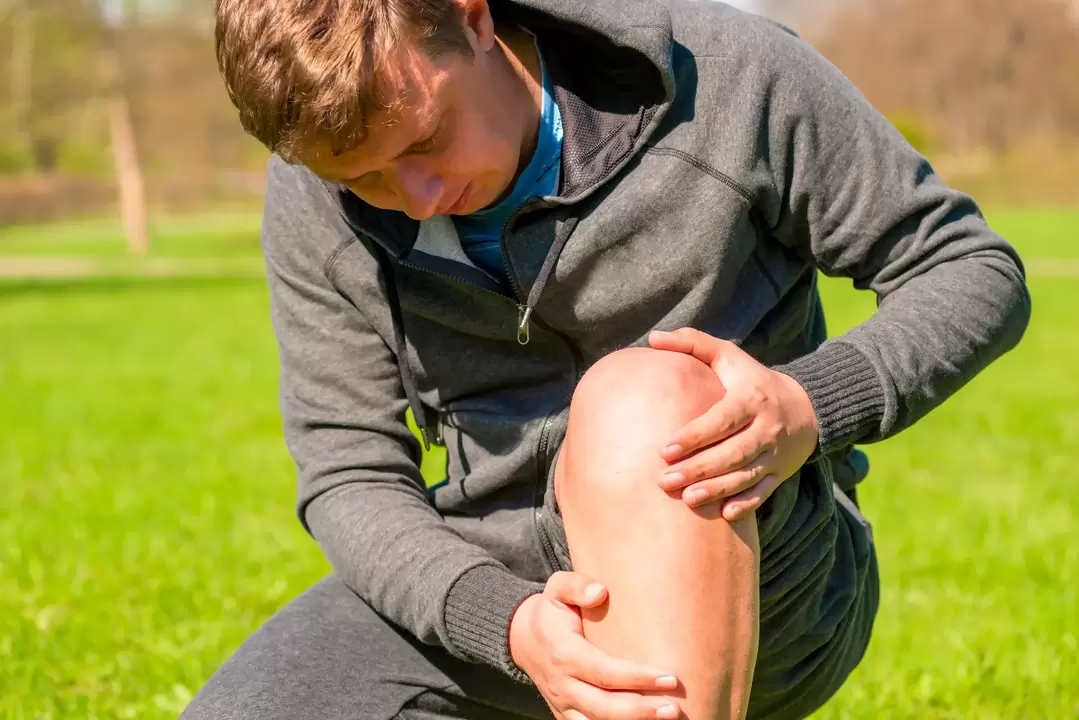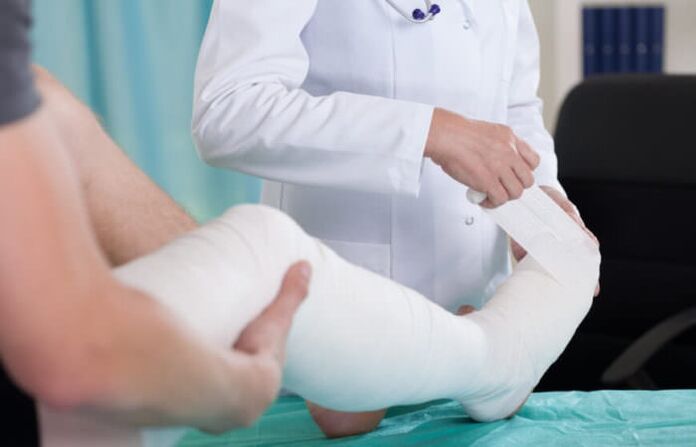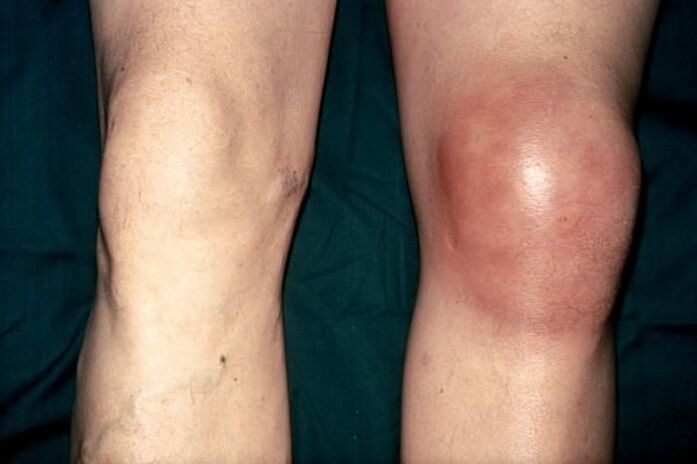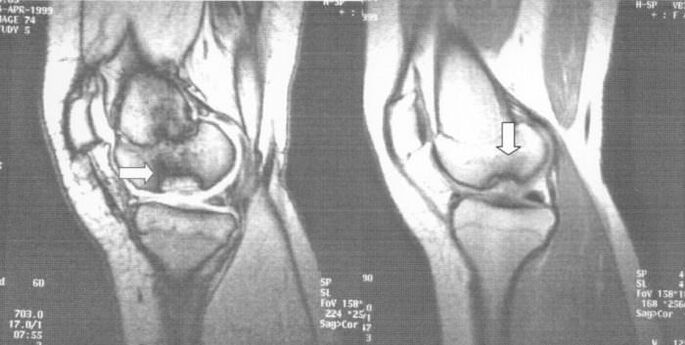Pain in the knee joint is a very common occurrence in a person's life. It can be due to many factors. As a rule, the main reason is that the knee joint is very prone to injury due to its anatomical structure and is subject to large daily loads, especially in overweight people. It is also possible for a symptom to appear during intensive sport, as part of everyday household or professional activities.
Causes of knee pain

The knee joint is made up of many different elements, each carrying its own functional load. Why do my knees hurt? The following factors can cause pain in the knee joint:
- traumatization;
- Damage;
- dystrophy of one of the elements.
Knee pain is a symptomatic manifestation of a variety of diseases of the knee joint. What Causes Knee Pain? In order to precisely determine the cause in individual cases, diagnostic measures are required. Pain can be the result of trauma from the elements:
- ligament apparatus;
- tendon formations;
- Damage to the cartilage lining.
For various diseases of the knee, in addition to pain, specific manifestations are characteristic, which are determined in laboratory studies, instrumental and others.
arthritis
If your knees hurt after a long period of rest or heavy exertion, it is arthritis. This pathology of the knee joint is detected in about 5-15% of patients who consult a doctor because of pain in the joint area.
Fact! Arthritis is a disease common to all age groups of the population, but young people are more susceptible to the disease.
A characteristic sign of most arthritis is a severe pain in the knee, that is, an acute onset - within 1-2 days.
Arthritis is an inflammatory process, so acute pain in the knee joint is accompanied by such signs:
- Edema;
- Swelling;
- hyperemia;
- severe pain that gets worse at night.
With arthrosis and damage to the meniscal cartilage, the pain manifests itself or intensifies with a motor load on the knee joint, that is, the pain is relieved when there is no load on the knee, in contrast to arthritis. With arthritis, the pain syndrome has a different etiology, and eliminating it by reducing the load and immobilizing the joint will not work. In addition, arthritis can affect multiple joints at once, with the exception of the knee.
arthrosis
Another very common knee disease, accompanied by severe pain. The pathology is found in 35-40% of people with knee pain, as a rule, this age group is over 40 years old, often both the left knee and the right knee are affected at the same time. Severe pain may not appear immediately, but the sensations gradually increase over time: for someone a week or two, for someone - for a month. In contrast to arthrosis, the knee only hurts under load:
- At first, after a long walk, a person feels pain.
- Over time, even walking short distances brings a lot of discomfort.
- Later, the patient has great difficulty climbing stairs.
- It is difficult to get up from a chair, that is, to loosen your knees with a load.
- The pain syndrome disappears when you rest, immobilize the joint.
Over time, without proper treatment, the symptoms are greatly aggravated:
- the joint is deformed;
- A crackling sound is heard when walking or straightening the knee.
- pain intensifies.
The pathogenesis is based on the destruction of the structure, the degeneration of the cartilaginous lining of the articular cavity, which leads to deformity of the joint. Primary arthrosis or age-related occurs as a result of the natural wear and tear of the cartilage, secondary - is the result of injuries or a number of other reasons. Such causes can be infectious arthritis, tumor lesions of bone or cartilage tissue, due to which this disease can occur in people of different age groups.
meniscopathies
They are also a common cause of joint pain.
For reference! Among patients who seek help because of knee joint pain, about 25-35% have meniscus injuries of various origins.
This pathology is found in people of all ages, in various professional activities, and is equally common among men and women. The menisci are injured during active movements:
- At the moment of injury, a characteristic click is heard, after which there can be severe pain in the knee.
- Then a crunch or crunch in the knee.
- After that, a sharp pain is felt, which intensifies.
- A person in this condition cannot move the knee joint at all.
The pain may subside after some time, and the meniscopathy becomes chronic. But without proper treatment, edema develops, the joint swells, and movements in it can become blocked, which is accompanied by severe pain and can lead to the development of arthrosis. The risk group is:
- people suffering from gout or arthritis of the joint;
- Diabetic;
- People with weak ligaments or overweight.
The disease is diagnosed using computed tomography or magnetic resonance imaging and is treated conservatively or surgically, depending on the severity.
tendinitis
Tendonitis is an inflammatory process in the tissues of muscle tendons at the site of their attachment. This disease most often affects active children and adolescents, athletes:
- cyclists;
- basketball player;
- volleyball player;
- Athlete.
The disease exists in two forms:
- Tenosynovitis is inflammation of the tendon sheath.
- Tendobursitis is a lesion of the tendon sac.
The cause of this phenomenon can be not only an injury associated with active movement, but also such diseases:
- Gout;
- Arthritis;
- immunodeficiency states;
- infectious diseases;
- excessive physical activity;
- Muscle imbalance of the forces acting on the joint.
In the case of tendonitis, the knees hurt paroxysmally, that is, the pain increases when the tendon is strained. In severe forms or in the later stages of the disease, the inflamed tendon can tear. The disease is diagnosed in various ways, sometimes it can be detected by laboratory methods, for example, if the cause is an infection.
However, if the cause is gout or inflammatory processes in the joint itself, then radiological examination methods and magnetic resonance imaging can detect the disease.

In the initial stages of the development of the disease, conservative therapy, which includes immobilization of the joint with plaster and restriction of motor activity, helps. Various drugs are prescribed:
- tissue repair agents;
- anti-inflammatory drugs;
- antibiotics.
Physiotherapeutic procedures are also prescribed. In advanced cases, necrosis involves surgical removal of dead tissue and plastic tendon formations.
knee bursitis
This is a disease of the articular bags, characterized by an inflammatory process and the presence of exudative fluid.
For reference! Bursitis is caused by constant, excessive stress on the joint.
If we talk about pathologies of an infectious nature, the following factors can be the cause:
- damage to the skin in the knee area;
- open wound injuries;
- various septic conditions;
- the presence of infection in the blood;
- overweight;
- increased load on the joint.
Pathology is also secondary, as a complication of gout or arthritis of the knee joint. Like any inflammatory process, bursitis is accompanied by symptoms:
- pain syndrome;
- noticeable changes in the shape of the joint;
- the presence of swelling in the knee area;
- redness;
- severe movement difficulties.
The severity and visibility of these manifestations depend on the severity and localization of the process.

Depending on the localization of the inflamed joint capsule, there are such types of pathologies:
- prepatellar;
- suprapatelary;
- infrapatellar bursitis.
As a rule, this pathology is quite easy to diagnose and treat, with the exception of cases in elderly patients, in which it is chronic and difficult to treat.
Baker's cyst
Another pathological phenomenon of the knee joint, which entails a lot of pain and problems. The cyst is also called popliteal hernia, it is a bulge in the popliteal fossa. There is usually an intertendon sac between the tendons, gastrocnemius and semimembranosus muscles at the back of the knee region. A pathological effusion is formed in the articular cavity as a result of the following factors, penetrating into the intertendon sac:
- Trauma;
- dystrophic changes;
- inflammatory processes.
As a result, the sac enlarges, becomes noticeable, and is known as a Baker's cyst. In the initial stages of development, it can be invisible, not causing obvious discomfort, that is, asymptomatic. Later, due to the increase in size, the knee hurts a lot, since the cyst begins to compress the nerves and blood vessels, and the mobility of the joint is also impaired. Flexion movements become difficult and are also accompanied by severe pain.
Dissection of osteochondrosis

This disease is also a common cause of knee pain. Normally, the articular surfaces that make up the knee joint are lined with cartilage. This pathology is caused by the fact that a small area of \u200b\u200bthe cartilage lining becomes necrotic and exfoliates, as a result of which a bare body is formed in the joint cavity, which causes many problems.
It manifests itself symptomatically as follows:
- mild pain and discomfort;
- when moving, the pain intensifies;
- swelling may develop.
A detached fragment of cartilage tissue, once in the articular cavity, can impede movement, which patients complain about, and when moving, you can hear characteristic clicks or a crunch. After peeling, a defect remains on the smooth joint surface, which contributes to traumatization of the joint and in the future will lead to osteoarthritis or other pathologies.
Doctors consider frequent joint injuries to be the cause of the development of this disease, but sometimes there are patients who do not have previous injuries. The diagnosis is based on the methods of computed tomography, magnetic resonance imaging and X-ray examination.
gout disease
Gout or gouty arthritis of the knee joint is caused by a disturbed metabolism, which leads to an excessive formation and deposition of uric acid salts, the so-called urates. They accumulate both in the joint cavity itself and around cartilage and tendons, causing inflammation.
With the disease, there is severe pain in the joint, the knee area becomes red and swollen. When gout becomes chronic, uric acid deposits cause significant deformity of the joint, resulting in injury, the impossibility of performing a normal range of motion.
Diagnosis of the disease is made with the help of X-rays and blood tests for uric acid. It is difficult to treat, but in the initial stages of development, special diets and drug treatment are used.
The causes of pain in the knee can be many different pathologies with completely different etiology and pathogenesis. The question of why the knee hurts can only be answered with certainty by a specialist after the diagnosis.
General principles of treatment
Everyone wonders if the knee hurts, what to do? Many people prefer to put up with the appearance of minor pain and discomfort, thinking that it will pass by itself, this should not be done. The knee joint hurts because it is a manifestation of various pathologies, and in the absence of timely, adequate therapy, these pathologies can lead to serious consequences.
If the knees hurt, the treatment involves therapy of the pathology that caused the pain. Based on the results of diagnostic studies, the doctor prescribes appropriate therapy and decides how to treat diseased joints. This can be the following methods:
- special therapeutic and preventive exercises;
- Anoint;
- compresses.
Anti-inflammatory substances are prescribed for inflammatory phenomena, and various chondroprotectors or corticosteroid drugs for problems with cartilage tissue.
For reference! A puncture is possible both for diagnosis and for treatment, for example in the case of a Becker cyst.
Sometimes with advanced pathology, surgical treatment is indicated, which is also diverse. In most cases, they resort to arthroscopic operations: to remove the body of the joint or to resect the area of \u200b\u200bthe affected tissue. Even if other therapies are ineffective, knee endoprosthetics are used, i. e. the replacement of joint elements or the entire joint with an artificial implant. Therefore, the answer to the question "what to do if the knee hurts" is an immediate visit to the doctor.















































